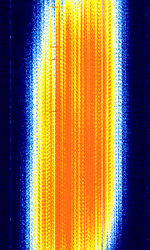Unknown 32p55 radar-like signal possibly SIMONe meteor radar
 | |
|---|---|
| Frequencies | 32.55 MHz |
| Frequency Range | 32.55 MHz - 32.55 MHz |
| Mode | AM |
| Modulation | unknown |
| ACF | — |
| Bandwidth | 140 kHz |
| Location | Worldwide |
| Short Description | Suspected meteor detection radar on low VHF band, possibly SIMONe radar. |
| I/Q Raw Recording | Download file |
| Audio Sample | |
This signal was spotted in northern Europe on 29th of June 2024 during good sporadic E conditions. Modulation was difficult to analyze, but there seems to be a 100 HzHertz (Hz), unit of frequency, defined as one cycle per second (1 Hz). component and possibly other patterns. The signal was interfered by a bursting data signal and getting a clean IQQuadrature signals form the basis of complex RF signal modulation and demodulation, both in hardware and in software, as well as in complex signal analysis. recording was difficult.
This is likely a radar, possibly a meteor detection radar. Possible candidate is SIMONe radar in Andenes, Norway or Juliusruh, Germany. [1][2][3] The SIMONe radar uses spread-spectrum technology with code repetition interval of 10 msmilliseconds (.001 of a second) (100 HzHertz (Hz), unit of frequency, defined as one cycle per second (1 Hz). rate) which would explain the 100 HzHertz (Hz), unit of frequency, defined as one cycle per second (1 Hz). component and strange modulation. It has a nominal bandwidth of 100 kHzKiloHertz (kHz) 10^3 Hz but this signal seems to spread a little bit more.
Samples[edit]
FMFrequency Modulation sample:
Frequencies[edit]
32.55 MHzMegaHertz (MHz) 10^6 HzVideo Examples[edit]
Additional Links[edit]
Additional Images[edit]
References[edit]
- ↑ https://forums.radioreference.com/threads/vhf-low-band-radars.455994/
- ↑ https://www.frontiersin.org/journals/astronomy-and-space-sciences/articles/10.3389/fspas.2022.886037/full
- ↑ https://www.iap-kborn.de/en/research/department-radar-remote-sensing/instruments/meteor-radars/juliusruh-meteor-radar/